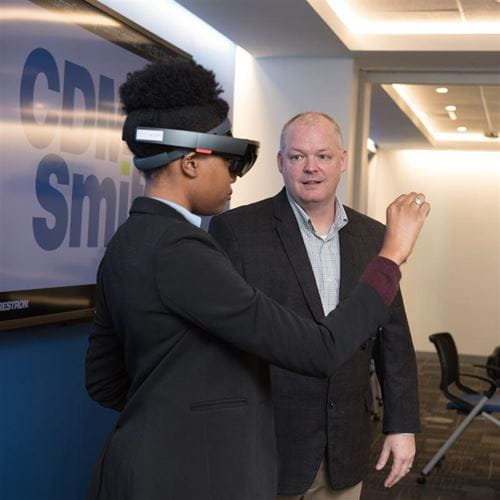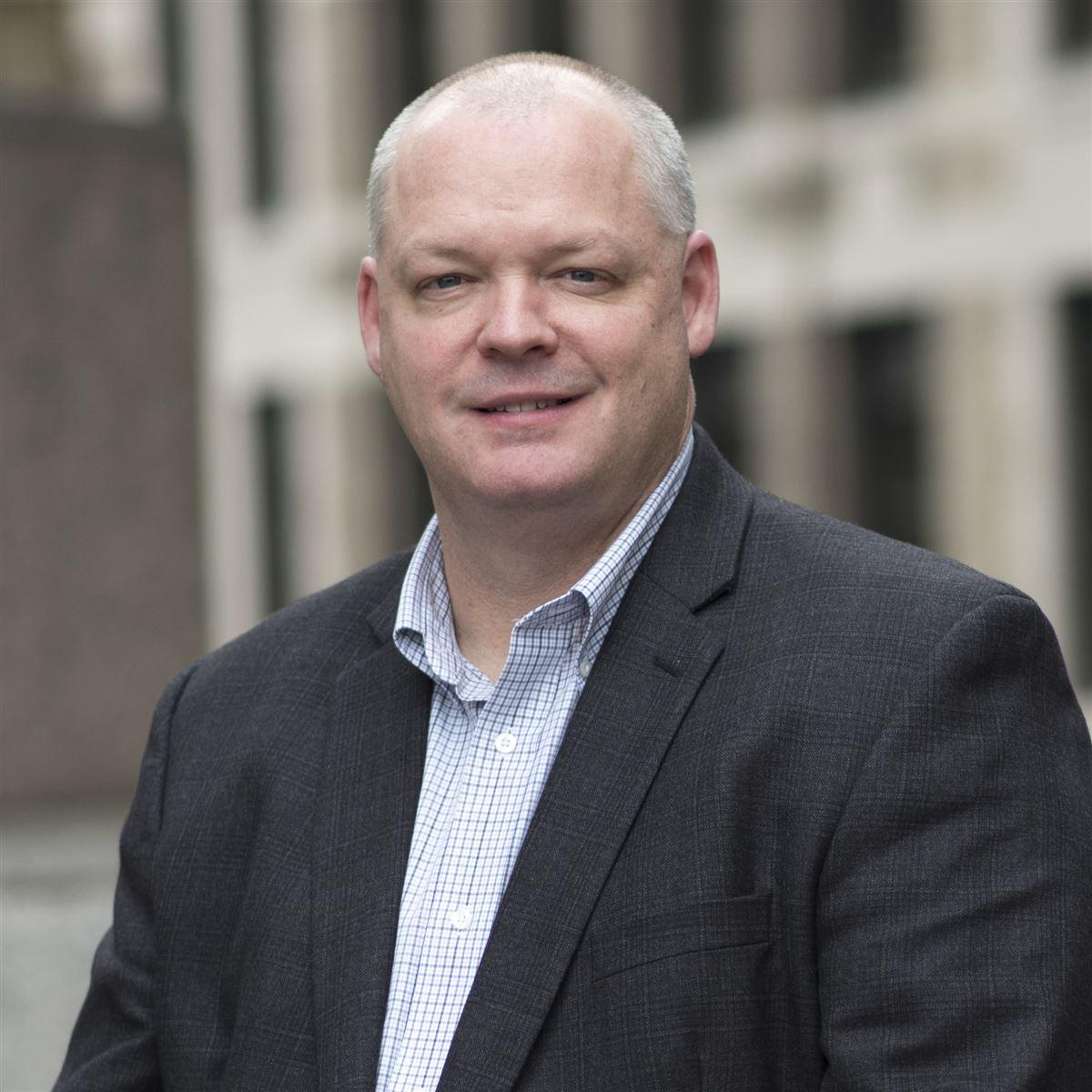State DOTs Take Tech Beyond the Hype to Solve Challenges
How can the transportation industry move beyond the hype of new technologies and find practical, lasting ways to harness them to solve growing mobility issues? More than 100 transportation professionals, representing nearly 30 state departments of transportation (DOT) gathered recently at the American Association of State Highway and Transportation Officials (AASHTO) 2019 Annual Meeting in St. Louis, Missouri, to delve deep into this topic. This interactive workshop, led by CDM Smith, centered on innovative technology and tools such as artificial intelligence (AI), the Microsoft HoloLens, drones and cloud data resources. Special presentations by Microsoft and three forward-looking DOTs—Texas, Pennsylvania and Ohio—demonstrated how the industry is breaking new ground by blending existing data and traditional methods with progressive technology.
As DOT leaders explore what technology can enable, one leader felt that 'DOTs are moving toward becoming mobility agencies, rather than infrastructure agencies.'
AI, including machine learning and computer vision, is on the brink of revolutionizing how we plan, develop, design, construct and operate transportation infrastructure. According to Jay Natarajan, U.S. AI Lead for Microsoft, “AI is the wave of the future, and its potential uses in transportation are immense.” The first steps in this exciting new arena are, in fact, already happening. There are ongoing efforts to test AI within traditional traffic engineering and operations by converging existing traffic video footage with machine learning and computer vision to demonstrate efficiencies in traffic counting, safety and overall analytics. Natarajan states that with the right input and training, an AI system is capable of monitoring and processing video streams more than 333 times faster than traditional traffic monitoring. According to Natarajan, computer vision and machine learning in this context could vastly improve our approach to safety, traffic management and mitigation, road designs and planning for future transportation needs.
While the capabilities and potential applications of emerging technologies, including AI, clearly offer promising opportunities, how are DOTs using available technologies today? To get to the heart of this, we asked workshop attendees to share their primary vision, expectations and challenges related to adopting and integrating technology. Here is what they said:
What is the top challenge facing your organization today that you are hoping technology can solve?
Other possible areas in which technology could help include communication, workforce development, congestion, and connectivity.
What is the biggest impediment to implementing new technology in your day-to-day operations or project delivery?
Data security and hacking are also major concerns. “IT security is [one of] the biggest impediments,” noted one participant. “It seems like we are so afraid of cyber attacks that is it stifling productivity, morale and effectiveness.” Further complicating things, state leaders believe that many DOTs are not adequately prepared to take advantage of AI. As another attendee expressed, “there is an overall lack of awareness on exactly what types of equipment or services need to be procured before AI can be implemented.” But despite fears, DOT leaders are beginning to embrace technology and explore options to help them move forward.
What is the top application or challenge that AI could help solve in your organization?
Many others also agreed that incident management, mitigation and asset management are likely to be enhanced through AI, with several noting that overall decision-making regardless of whether it’s maintenance, operations or design could benefit from it.
As technology continues to rapidly evolve, states have struggled to keep up with how to best use tools and prepare for the future. However, workshops like the one at AASHTO pave the way for more frank discussions and freeform peer-to-peer exchange, leading to real discovery of what works and doesn’t work. States such as Pennsylvania, Texas and Ohio have demonstrated that, by embracing technology and facing challenges head-on, they can deliver successful projects.
New Approaches to Public Involvement for TxDOT’s U.S. 67 Corridor Master Plan
At 142 miles long, the rural and unique U.S. 67 corridor stretches across multiple communities with diverse needs and priorities. Challenged by increasing freight traffic and safety issues caused by an expanding population, trade, tourism and oilfield growth, TxDOT is preparing the US 67 Corridor Master Plan to proactively address concerns and achieve goals of several stakeholders and communities involved. The project team recognized that they needed a strategic, multi-pronged public involvement and engagement plan. According to Marc Williams, Deputy Executive Director for TxDOT, it was imperative that the plan be innovative and creative to not only capture the attention of the affected communities, but also help them envision the alternatives in a very real way. To achieve this, TxDOT worked with the CDM Smith team to devise an approach comprised of traditional and virtual tools, special branding, focus groups, tours and social media. In addition, the team leveraged the Microsoft HoloLens, a pioneering mixed reality device, to visually communicate alternatives and showcase potential options. The HoloLens visualization techniques allowed residents and stakeholders to walk through 3D holographic models of the corridor roadway alternatives corridor and see different scenarios before the design phase begins and without having to physically be outside in traffic.

State DOTs can gain so much from sharing ideas and collaborating to leverage new technologies to improve transportation.

The AASHTO annual was a great opportunity for the DOTs to learn about the potential of artificial intelligence and other technologies in solving future challenges.

Public involvement is one of the most challenging components of any project, agreed workshop attendees. Polling, 3D models and plans, websites and virtual meetings are tools that often work well, but to optimize effectiveness, they are best combined into one succinct, comprehensive plan. As one participant noted, online public involvement meetings “help us get thousands [of people] engaged in participation.” Project websites must be engaging and kept up to date with ample information and data. In addition, video is particularly powerful in sharing and communicating information to a diverse audience. One participant said it best: “If a picture is worth a thousand words, a video is worth millions.”
Despite benefits of these innovative tools, DOTs face funding constraints and limitations, which can create challenges in incorporating corridor visualizations into the design process. It requires a balanced approach, noted one attendee. However, projects such as the U.S. 67 Corridor Master Plan demonstrate how DOTs can and have embraced technology successfully to draw in the community and make them feel a part of the process.
Anticipating the Impacts of Connected and Automated Vehicles via Transportation Demand Modeling in Ohio
Travel demand models are used to forecast traffic flows by evaluating the relationship between supply (by daily peak times) and demand, with respect to geography and travel modes. In general, these models help to identify potential future system deficiencies, emission estimates and congestion management needs. As the industry moves toward a network inclusive of connected and automated vehicles (CV/AVs), DOTs will also need to adapt travel demand models to accommodate these advances, which are critical to planning and investment decisions.
Chief Engineer and Assistant Director for Transportation Policy Lloyd MacAdam shared what the Ohio DOT is doing to prepare for and assess potential impacts of transformative technologies such as CV/AVs, ride sharing and drone delivery on travel behavior, safety and congestion. Through the Connected and Automated Vehicle Simulation Modeling Study, led by CDM Smith, Ohio is conducting a comprehensive review of CV/AV applications (including vehicle-to-vehicle, vehicle-to-infrastructure, and passenger vehicle vs. truck) to determine the expected rate of adoption, and how they could reduce traffic congestion and improve safety, traffic speeds, capacity issues and reliability. This study will also provide recommendations regarding which locations and traffic conditions are most amenable to these applications. Looking ahead, specific simulations will be conducted where CV/AV market penetration is most expected. Building on this study, ODOT is testing two microsimulation scenarios that focus on CV/AV impacts to local roadways and moderately congested freeways.
While this is a pioneering study in transportation modeling and will clearly benefit Ohio’s future transportation systems, most states are in varying stages of readiness to conduct progressive studies like it. Leaders attending the workshop noted that better coordination with the auto industry is a likely prerequisite to embarking on advanced CV/AV modeling efforts.
Preparing for Emerging Technologies through Design and Construction
As many agencies work to integrate technology early in the project development process, others prioritize technology in design and construction to improve safety, asset management and overall operational/cost effectiveness. George McAuley, Jr., Deputy Secretary for Highway Administration at the Pennsylvania DOT, talked about the agency’s new Connected and Automated Vehicles Committee for Design and Construction. Its focus is on staying informed; understanding technology implications; evaluating public, peer and private partnerships; and, embracing initiatives such as PennSTART, a state-of-the-art training and testing facility that addresses transportation safety and operations needs throughout Pennsylvania and the mid-Atlantic. This 110-acre site is designed to enhance emergency response, transportation networks and future research centers around six key areas: traffic incident management, tolling and intelligent transportation systems technology, work zones, transit vehicles and CV/AVs. As McAuley noted, through efforts such as PennSTART, Pennsylvania is proactively setting a vision that can be evolved and adapted to, and along with, industry and technological advancements.
Although technology is a hot topic in nearly every industry, it continues to dominate discussions in the public and private transportation space. Ground-breaking transportation initiatives, successful uses of technology in real-world projects and progressive pilot projects, such as those outlined at the AASHTO workshop, validate that transportation technology is more than just hype. These tools and advancements are useable, cost-saving and beneficial in delivering lasting projects for the future. A workshop attendee concluded, “The industry is so rapidly changing that it’s nearly impossible to keep up, but being proactive, collaborative and open to new ideas will go a long way in maintaining alignment with department and community goals.” One state leader aptly framed the changing landscape this way: “As agencies, we are moving toward becoming mobility agencies and away from [traditional] infrastructure agencies.”










